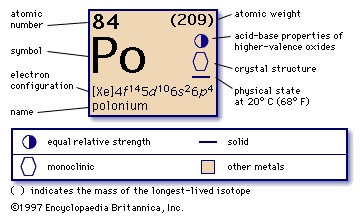polonium
chemical element
 a radioactive, silvery-gray or black metallic element of the oxygen group (oxygen group element) (Group 16 【VIa】 in the periodic table). The first element to be discovered by radiochemical analysis, polonium was discovered in 1898 by Pierre (Curie, Pierre) and Marie Curie (Curie, Marie), who were investigating the radioactivity of a certain pitchblende, a uranium ore. The very intense radioactivity not attributable to uranium was ascribed to a new element, named by them after Marie Curie's homeland, Poland. The discovery was announced in July 1898. Polonium is extremely rare, even in pitchblende: 1,000 tons of the ore must be processed to obtain 40 milligrams of polonium. Its abundance in the Earth's crust is about one part in 1015. It occurs in nature as a radioactive decay product of uranium, thorium, and actinium. The half-lives of its isotopes range from a fraction of a second up to 103 years; the most common natural isotope of polonium, polonium-210, has a half-life of 138.4 days.
a radioactive, silvery-gray or black metallic element of the oxygen group (oxygen group element) (Group 16 【VIa】 in the periodic table). The first element to be discovered by radiochemical analysis, polonium was discovered in 1898 by Pierre (Curie, Pierre) and Marie Curie (Curie, Marie), who were investigating the radioactivity of a certain pitchblende, a uranium ore. The very intense radioactivity not attributable to uranium was ascribed to a new element, named by them after Marie Curie's homeland, Poland. The discovery was announced in July 1898. Polonium is extremely rare, even in pitchblende: 1,000 tons of the ore must be processed to obtain 40 milligrams of polonium. Its abundance in the Earth's crust is about one part in 1015. It occurs in nature as a radioactive decay product of uranium, thorium, and actinium. The half-lives of its isotopes range from a fraction of a second up to 103 years; the most common natural isotope of polonium, polonium-210, has a half-life of 138.4 days.Polonium usually is isolated from by-products of the extraction of radium from uranium minerals. In the chemical isolation, pitchblende ore is treated with hydrochloric acid, and the resulting solution is heated with hydrogen sulfide to precipitate polonium monosulfide, PoS, along with other metal sulfides, such as that of bismuth, Bi2S3, which resembles polonium monosulfide closely in chemical behaviour, though it is less soluble. Because of the difference in solubility, repeated partial precipitation of the mixture of sulfides concentrates the polonium in the more soluble fraction, while the bismuth accumulates in the less soluble portions. The difference in solubility is small, however, and the process must be repeated many times to achieve a complete separation. Purification is accomplished by electrolytic deposition. It can be produced artificially by bombarding bismuth or lead with neutrons or with accelerated charged particles.
Chemically, polonium resembles the elements tellurium and bismuth. Two modifications of polonium are known, an α- and a β-form, both of which are stable at room temperature and possess metallic characteristics. The fact that its electrical conductivity decreases as the temperature increases places polonium among the metals rather than the metalloids or nonmetals.
Because polonium is highly radioactive—it disintegrates to a stable isotope of lead by emitting alpha rays, which are streams of positively charged particles—it must be handled with extreme care. When contained in such substances as gold foil, which prevent the alpha radiation from escaping, polonium is used industrially to eliminate static electricity generated by such processes as paper rolling, the manufacture of sheet plastics, and the spinning of synthetic fibres. It is also used on brushes for removing dust from photographic film and in nuclear physics as a source of alpha radiation. Mixtures of polonium with beryllium or other light elements are used as sources of neutrons.
atomic number
84
atomic weight
210
melting point
254 °C (489 °F)
boiling point
962 °C (1,764 °F)
density
9.4 g/cm3
oxidation states
−2, +2, +3(?), +4, +6
electronic config.
1s22s22p63s23p63d104s24p64d104f145s25p65d106s26p4
- hylozoism
- Hylton, R. Dale
- Hyman G. Rickover
- Hyman, Libbie Henrietta
- Hymans, Paul
- Hymen
- hymenium
- hymenomycetes
- Hymenophyllaceae
- hymenopteran
- hymenostome
- Hymettus, Mount
- hymn
- Hyndburn
- Hyndman, Henry Mayers
- Hypatia
- Hypecoeae
- hyperaldosteronism
- hyperammonemia
- hyperbaric chamber
- hyperbaton
- hyperbola
- hyperbole
- hyperbolic functions
- hyperbolic geometry